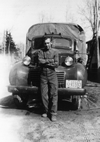10. The Job
SERAFINO BOARDED the SS. Taormina at Naples in March 1912. He arrived in New York City 16 days later and took the train south to Philadelphia. He was 26.
His old friends heard that a company in Allentown, Pennsylvania, was recruiting workers. “Lehigh Portland Cement Company,” one friend mentioned to Serafino. “About 70 miles north of here. Up near the bend of the Lehigh River.”
“Lehigh River!” Serafino kept silent but raised his eyebrows, his mind drifting into space as he recalled the end of his search of years ago. “Could it possibly be?”
“They’re hiring immigrants,” another friend shook Serafino by the shoulder, “because Americans won’t do the work. Let’s go!”
“We need men to work in a quarry in a faraway place called Mason City, Iowa,” the hiring supervisor informed Serafino. The site had been chosen because of its large deposits of limestone, glacial till, and blue clay. “We need men to extract the raw materials for producing gray cement. We offer housing as well as jobs.”
It sounded too good to be true. Serafino thought he must have misinterpreted the supervisor’s English. “You say both house and job?” Serafino asked.
“Yes,” the supervisor confirmed. “Both house and job.” There was just one hitch: “We need men to start work immediately. Otherwise, no deal.”
Serafino voiced just one hesitation: “When could I return to Italy for my wife?”
“You do good work for six months,” the supervisor grumbled. “Then you can get your wife.”
“Perfect!” Serafino agreed. He needed to work at least six months anyway to save enough money to bring her back.
From May to November 1912, Serafino drilled the bedrock on the outskirts of Mason City, Iowa. He then returned to Farindola with the money to retrieve Maria.
